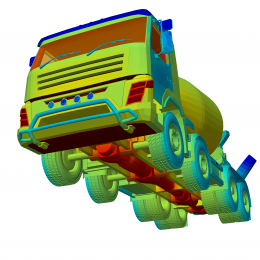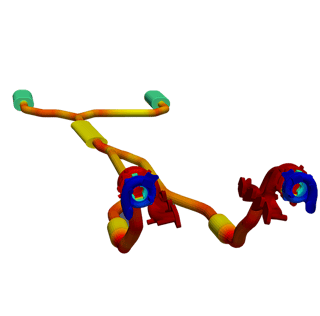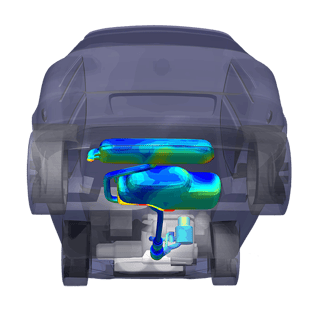Understanding the thermal behavior of underbody components can help an engineer balance the priorities and tightening restrictions for vehicle design. The underbody of a vehicle experiences some of the most thermally dramatic scenarios for which there is no simple solution. By using a method that provides accurate thermal predictions, engineers can assess a variety of design options early in the product development cycle. These predictions will provide a better understanding of the thermal behavior the vehicle will undergo under both extreme and common scenarios.

Underbody Design Has Many Competing Demands
OEMs face many competing demands when engineering the underbody of a vehicle. The foremost concern is safety and packaging. If it was possible components could be spread apart, but since it all has to fit, engineers need to be able to predict the thermal behavior of these components in close proximity. Exceeding safe temperatures could result in damaged components, part failures, recalls, warranty issues, and more. With the growing prevalence of compact designs, there is not a lot of room to put parts. Additionally, the push to make vehicles lighter and more fuel-efficient means engineers work hard to find solutions other than heavy heat shielding. A clear vision of what the vehicle's components will experience will ensure that all parts will withstand the most strenuous activities without being over-engineered.
Many of these peak temperatures occur after a vehicle is shut off. When the engine is off, there is less cooling air moving through the system, but large components such as the engine and exhaust system remain at elevated temperatures. Radiation from these components to others form convective plumes. These hot areas of air then rise causing the temperature of other components to increase. This type of scenario is best modeled in transient simulation to account for the radiation and convective effects.

Not only are engineers seeking to manage the thermal behavior for one specific set of components but often multiple variations, endeavoring to understand if other parts or vehicle variations could lead to a cost-savings, weight savings, or safer operating conditions. Many OEMs are looking to shorten production cycles which makes it difficult to budget time for this type of design exploration.
Balance Priorities with Thermal Simulation
Adopting a simulation method can allow engineers to predict thermal behaviors which in turn will help them balance these types of priorities. Thermal simulation software can model peak temperatures, daily driving scenarios, part locations, environments, and design variations so that an engineer can determine the right placement for components and the correct materials for heat shields.

Simulation software that can model all modes of heat transfer, as well as transient scenarios will also deliver a real-world picture of how a design will perform. Engineers can then optimize the vehicle's design early in production, saving valuable time and resources as well as expensive design problems. A design methodology using simulation helps OEMs accommodate these priorities along with shortened production cycles to help predict design compatibility for their vehicles.
Stay Competitive with Simulation
The industry is only going to continue to push the boundaries on these priorities, hoping to make their vehicles safer, lighter, and more efficient, both in operation and in their design process. Adopting simulation into your process can help you stay competitive, ensuring you can keep to an ambitious timeline while creating vehicles that exceed expectations.
